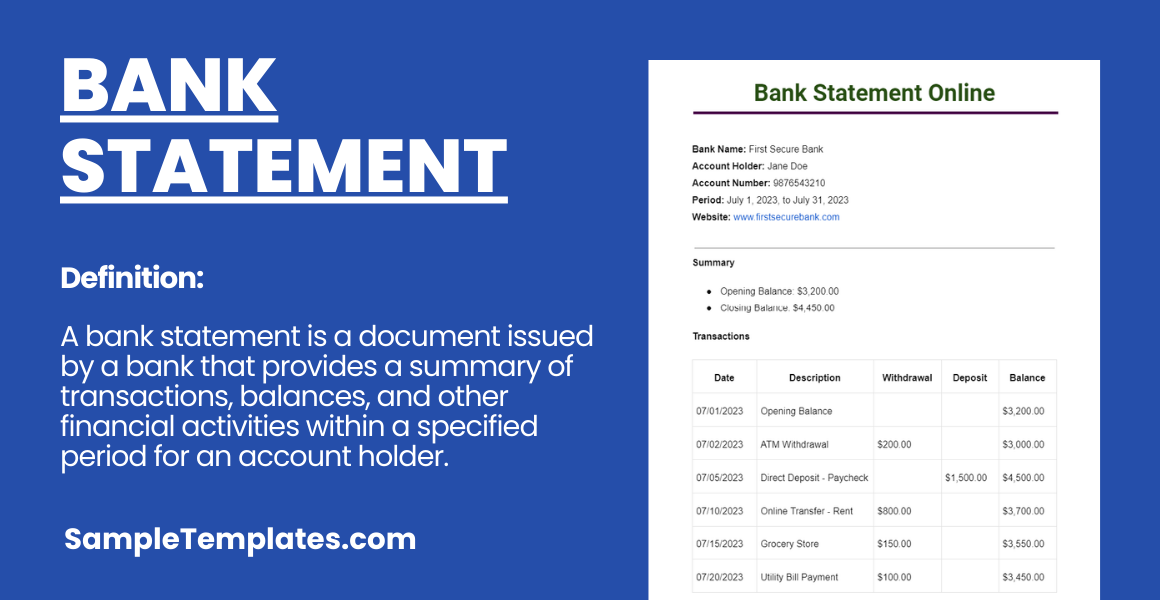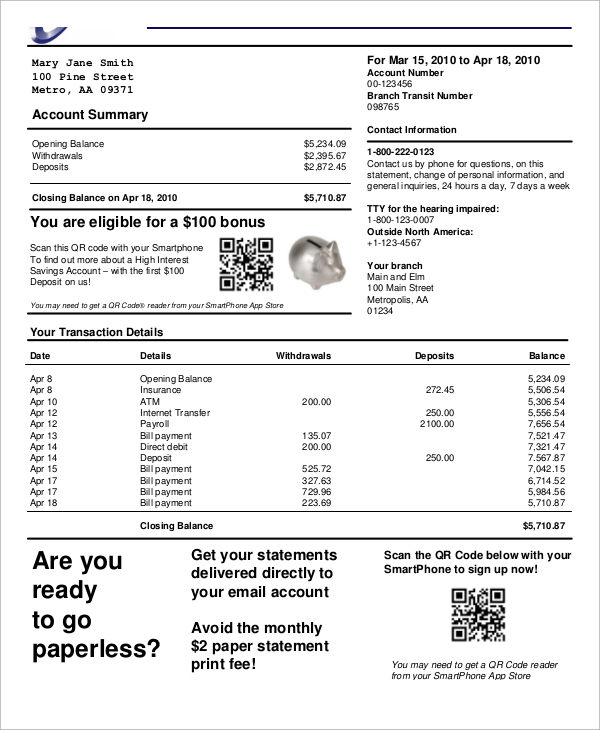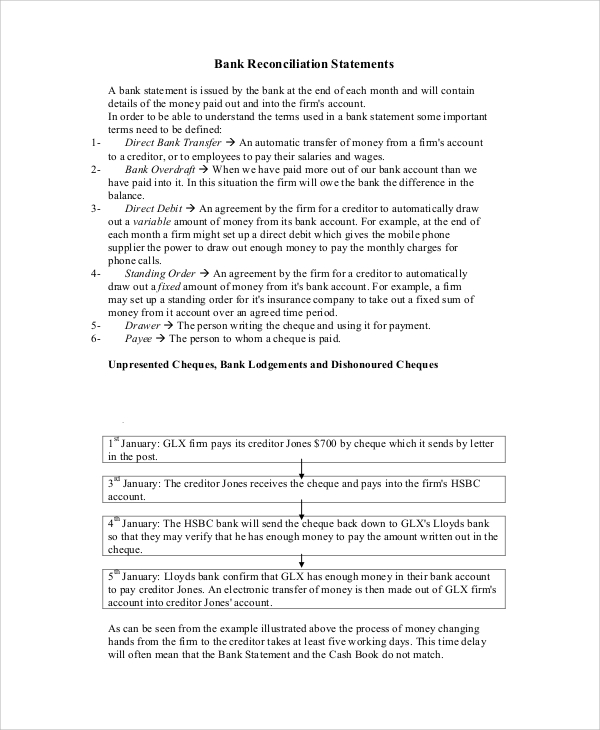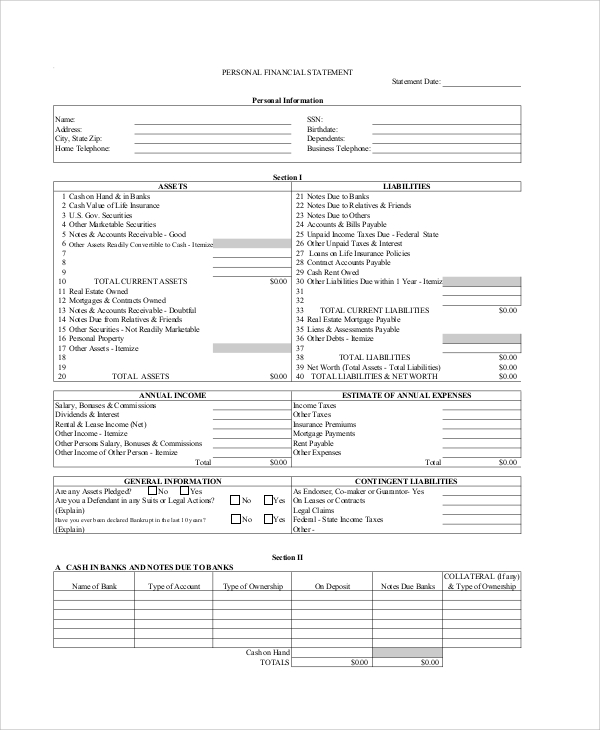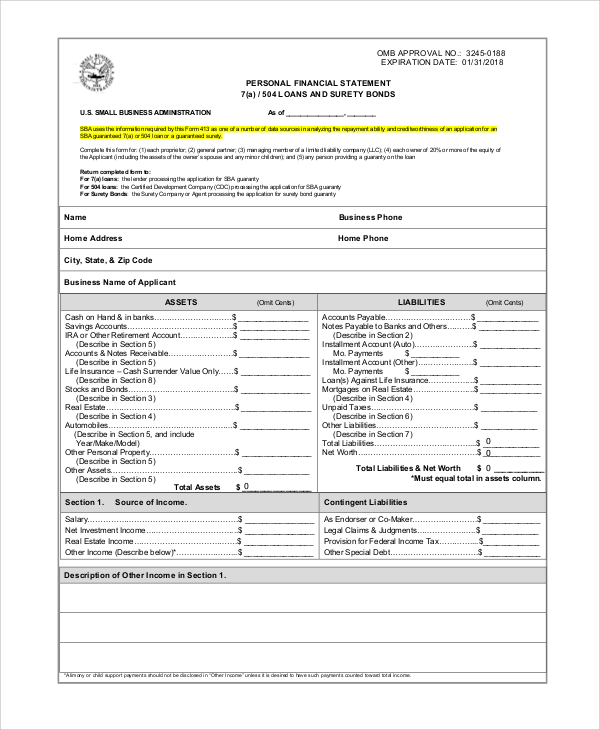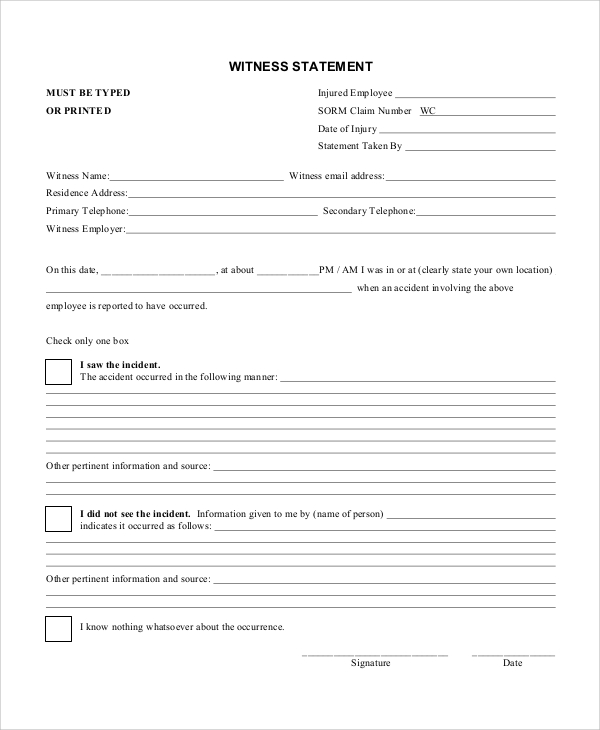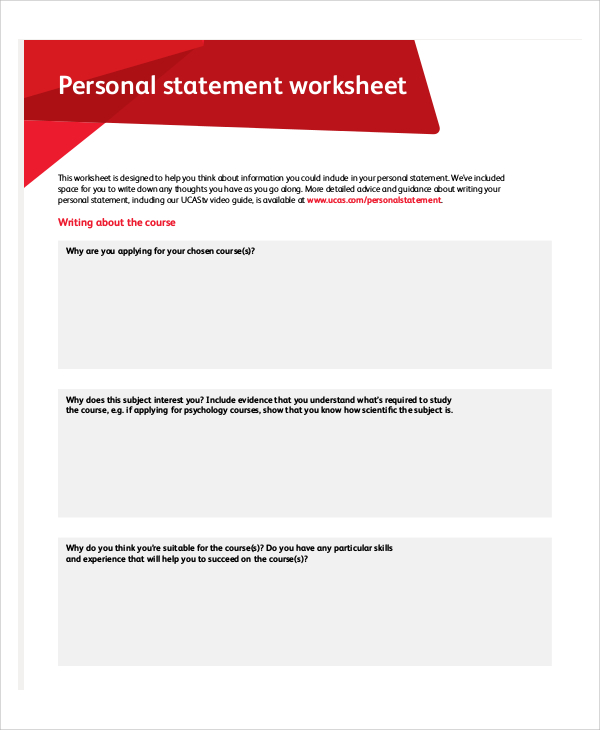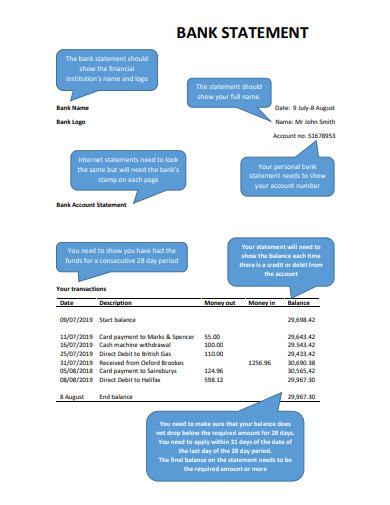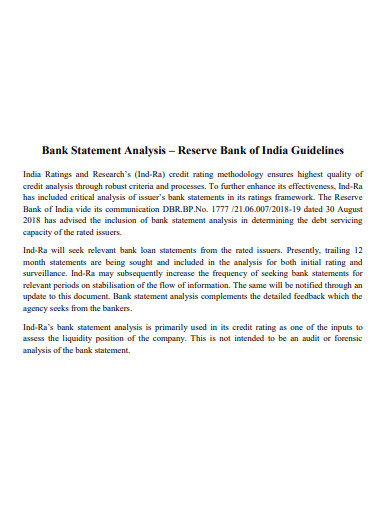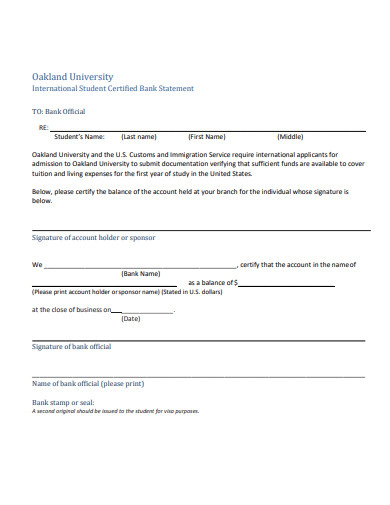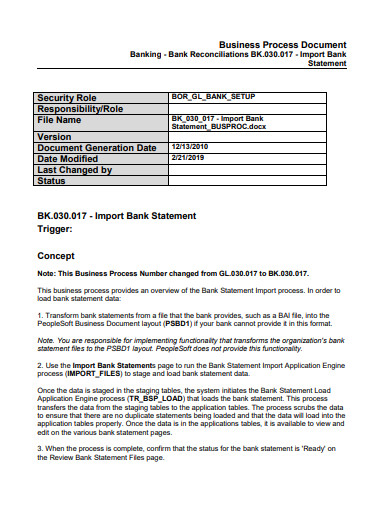In business, cash and bank transaction are leading sources for generating the revenues or income. It is essential to keep a proper book of record for such transaction of the cash or credits done through banks. The Bank Statement sample conveys all the relevant information about the debit and credit transaction. It could be used for future references as well.

Download Bank Statement Bundle
Dummy Bank Statement
Bank Name: People’s Trust Bank
Customer Name: John A. Doe
Account Number: 123-456-789
Statement Period: July 1, 2023 – July 31, 2023
Address: 123 Maple Street, Anytown, AT 12345
Account Summary
Opening Balance: $5,000.00
Closing Balance: $4,250.00
Transactions
| Date | Description | Withdrawals | Deposits | Balance |
|---|---|---|---|---|
| 07/01/2023 | Opening Balance | – | – | $5,000.00 |
| 07/02/2023 | Electric Bill Payment | $250.00 | – | $4,750.00 |
| 07/05/2023 | Grocery Store | $150.00 | – | $4,600.00 |
| 07/08/2023 | Salary Deposit | – | $1,000.00 | $5,600.00 |
| 07/12/2023 | Online Shopping – Z-Mart | $100.00 | – | $5,500.00 |
| 07/15/2023 | Cash Withdrawal – ATM | $200.00 | – | $5,300.00 |
| 07/18/2023 | Car Insurance Premium | $350.00 | – | $4,950.00 |
| 07/22/2023 | Coffee Shop | $20.00 | – | $4,930.00 |
| 07/25/2023 | Gas Station | $50.00 | – | $4,880.00 |
| 07/28/2023 | Water Bill Payment | $300.00 | – | $4,580.00 |
| 07/30/2023 | Gym Membership Fee | $80.00 | – | $4,500.00 |
| 07/31/2023 | Movie Streaming Service Subscription | $50.00 | – | $4,450.00 |
| 07/31/2023 | Monthly Maintenance Fee | $200.00 | – | $4,250.00 |
Fees & Charges
- Monthly Maintenance Fee: $200.00
- ATM Withdrawal Fee (non-network): Included in transactions
Notes:
- Keep your bank statement for your records.
- Review your statement regularly to monitor your account activity.
- Contact People’s Trust Bank immediately if you notice any unauthorized transactions.
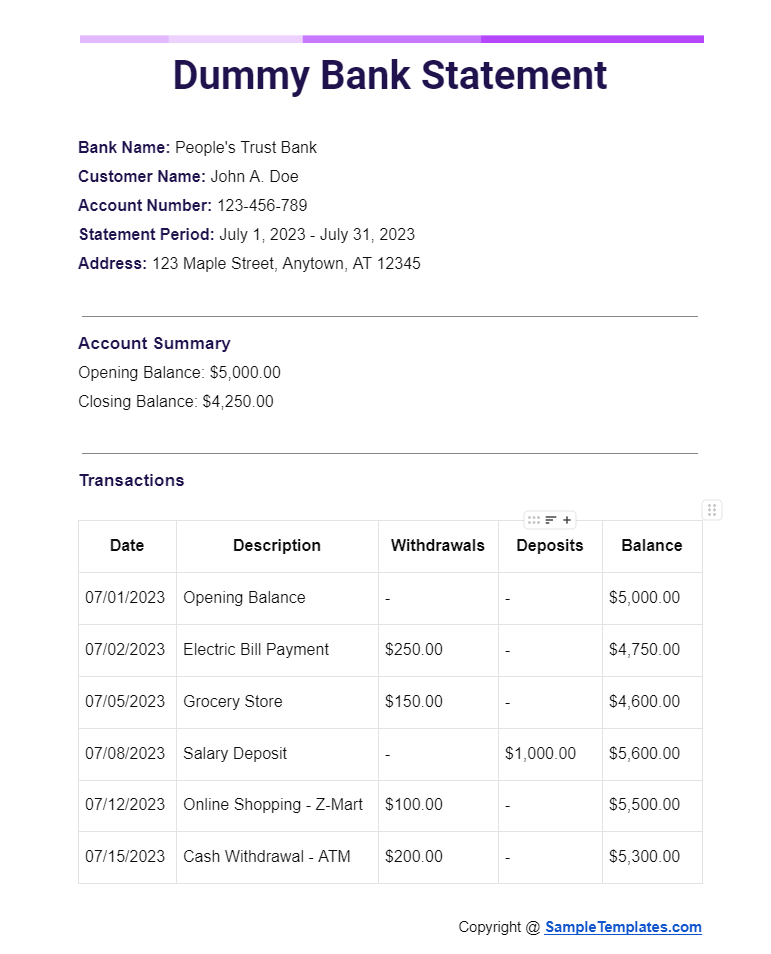
Bank Statement in Accounting
Document Type: Bank Statement
Purpose in Accounting: Provides a detailed summary of transactions within a bank account for a specified period, typically on a monthly basis.
Content:
- Transaction Details: Includes information on deposits, withdrawals, bank charges, and interest, complete with dates, descriptions, and amounts.
- Opening Balance: Indicates the amount present in the account at the start of the statement period.
- Closing Balance: Shows the account balance at the end of the statement period.
Uses in Accounting:
- Facilitates account reconciliation by comparing the recorded balance against the bank-reported balance, ensuring accuracy and identifying discrepancies.
- Essential for monitoring cash flow, providing insights into the financial health of the business by tracking revenues and expenditures.
- Serves as third-party verification for transactions recorded in the company’s cash account ledger, supporting the accuracy of financial records.
- Helps in detecting potential fraud, errors, and unauthorized transactions, safeguarding the company’s assets.
- Aids in financial analysis and planning, contributing to effective budgeting, forecasting, and strategic decision-making.
- Critical for compliance and auditing purposes, offering documented evidence required for tax preparation, auditing processes, and adhering to regulatory standards.
Importance:
The bank statement is a key financial document in accounting, providing an objective and comprehensive record of all transactions affecting a business’s bank account. It supports effective financial management, accountability, and compliance, playing an integral role in maintaining the financial health and integrity of a business.
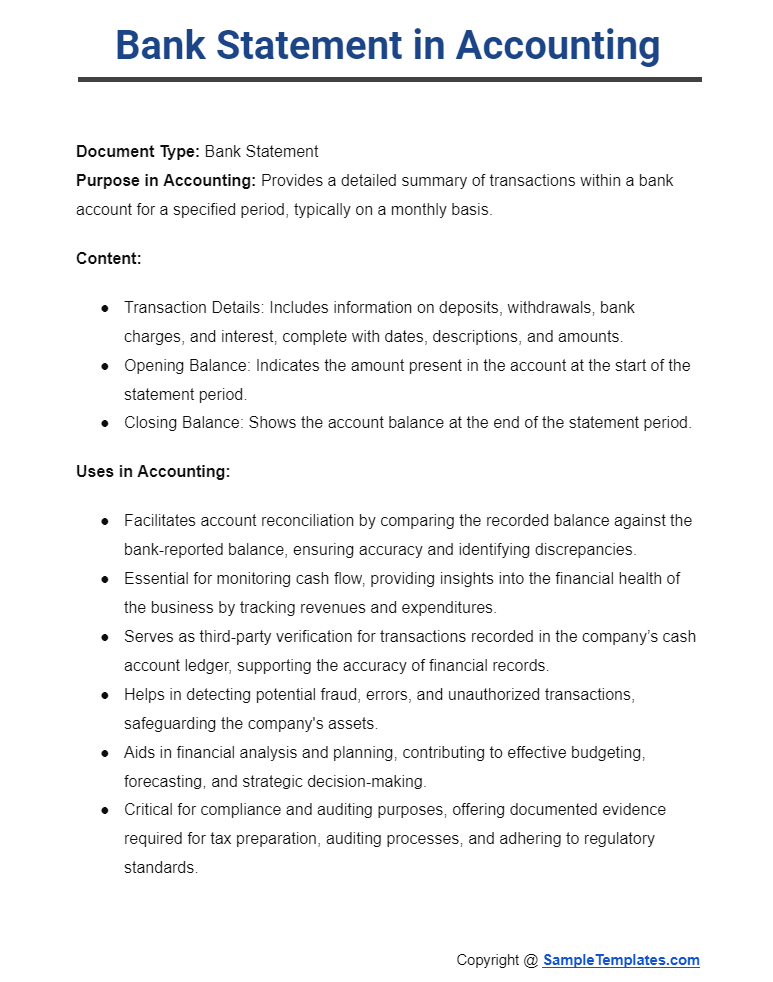
Bank Statement Online
Bank Name: First Secure Bank
Account Holder: Jane Doe
Account Number: 9876543210
Period: July 1, 2023, to July 31, 2023
Website: www.firstsecurebank.com
Summary
- Opening Balance: $3,200.00
- Closing Balance: $4,450.00
Transactions
| Date | Description | Withdrawal | Deposit | Balance |
|---|---|---|---|---|
| 07/01/2023 | Opening Balance | $3,200.00 | ||
| 07/02/2023 | ATM Withdrawal | $200.00 | $3,000.00 | |
| 07/05/2023 | Direct Deposit – Paycheck | $1,500.00 | $4,500.00 | |
| 07/10/2023 | Online Transfer – Rent | $800.00 | $3,700.00 | |
| 07/15/2023 | Grocery Store | $150.00 | $3,550.00 | |
| 07/20/2023 | Utility Bill Payment | $100.00 | $3,450.00 | |
| 07/25/2023 | Deposit – eBay Sale | $1,000.00 | $4,450.00 |
Access Your Statement Online:
- Instructions: Log in at www.firstsecurebank.com or use our mobile app with your credentials. Navigate to “Statements” to view or download your current or past statements.
Benefits of Online Statements:
- Access your statement anytime, anywhere.
- Enhanced security and reduced risk of identity theft.
- Environmentally friendly with less paper waste.
- Immediate access to current and historical transactions.
For More Information or Assistance:
Contact our support team at [email protected] or call us at (123) 456-7890.
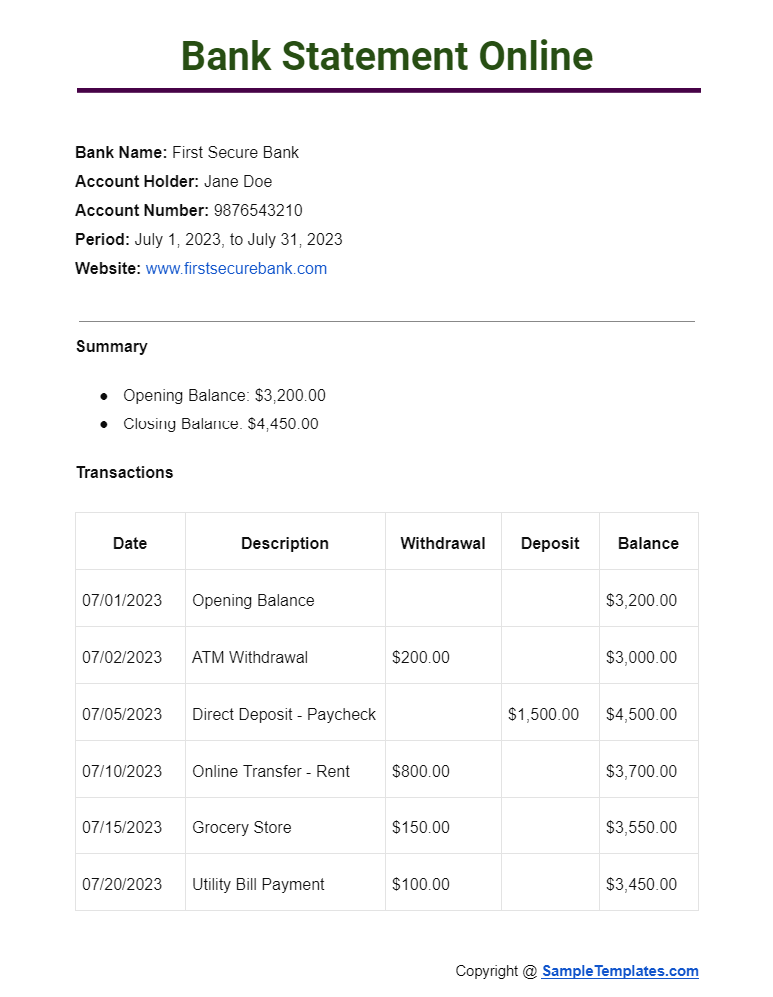
3 Months Bank Statement
Bank: Global Trust Banking Corp
Account Holder: Alex Martinez
Account Number: 456-789-123
Statement Period: April 1, 2023, to June 30, 2023
April 2023 Summary
Opening Balance: $5,600.00
Closing Balance: $6,850.00
Transactions for April
| Date | Description | Withdrawal | Deposit | Balance |
|---|---|---|---|---|
| 04/01/2023 | Opening Balance | $5,600.00 | ||
| 04/03/2023 | Coffee Shop | $25.00 | $5,575.00 | |
| 04/07/2023 | Direct Deposit – Salary | $2,500.00 | $8,075.00 | |
| 04/15/2023 | Online Shopping | $150.00 | $7,925.00 | |
| 04/22/2023 | Electric Bill Payment | $125.00 | $7,800.00 | |
| 04/30/2023 | Rent Payment | $950.00 | $6,850.00 |
May 2023 Summary
Opening Balance: $6,850.00
Closing Balance: $7,005.00
Transactions for May
| Date | Description | Withdrawal | Deposit | Balance |
|---|---|---|---|---|
| 05/01/2023 | Opening Balance | $6,850.00 | ||
| 05/05/2023 | Grocery Store | $200.00 | $6,650.00 | |
| 05/12/2023 | Direct Deposit – Salary | $2,500.00 | $9,150.00 | |
| 05/20/2023 | Gym Membership | $50.00 | $9,100.00 | |
| 05/28/2023 | Rent Payment | $2,095.00 | $7,005.00 |
June 2023 Summary
Opening Balance: $7,005.00
Closing Balance: $5,460.00
Transactions for June
| Date | Description | Withdrawal | Deposit | Balance |
|---|---|---|---|---|
| 06/01/2023 | Opening Balance | $7,005.00 | ||
| 06/03/2023 | Weekend Getaway | $800.00 | $6,205.00 | |
| 06/07/2023 | Direct Deposit – Salary | $2,500.00 | $8,705.00 | |
| 06/15/2023 | Car Insurance | $245.00 | $8,460.00 | |
| 06/25/2023 | Rent Payment | $3,000.00 | $5,460.00 |
End of Statement
For inquiries or to dispute any transactions, please contact our customer service at [email protected] or call us at (800) 123-4567.
Note: This document is a fictional example of a 3-month bank statement, designed for illustrative purposes.
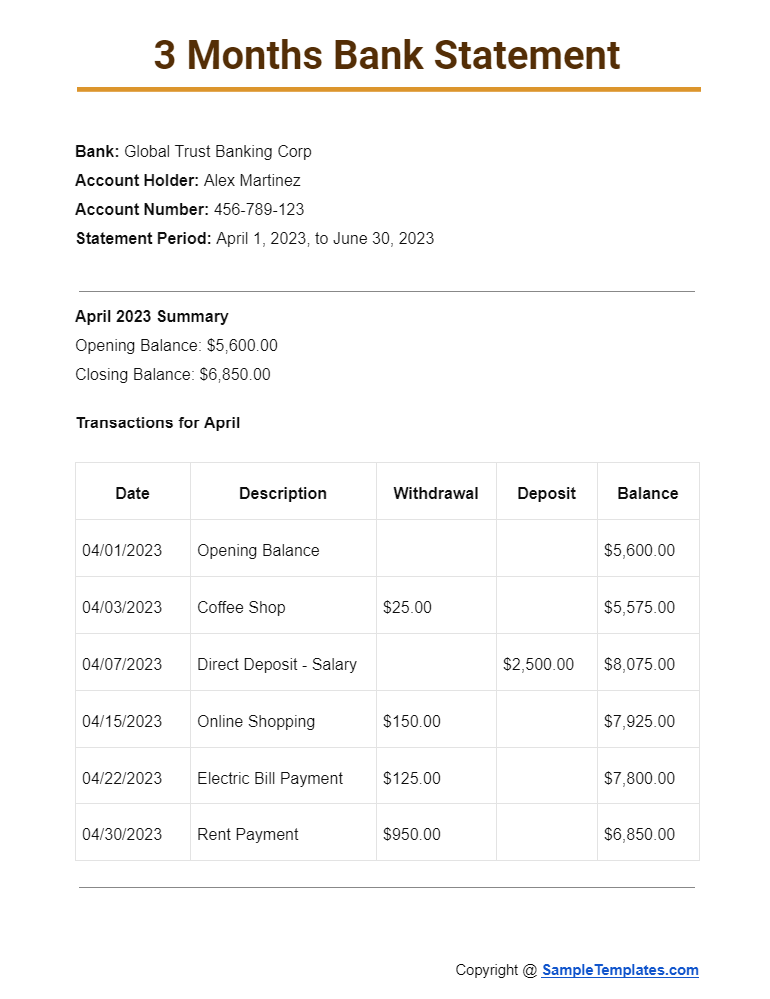
Browse More Templates On Bank Statement
Sample Bank Statement Template
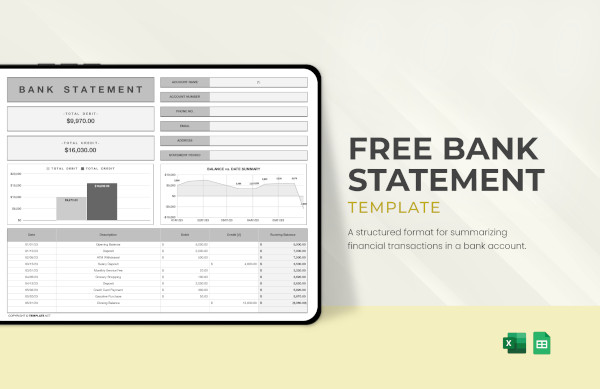
Sample Bank Account Statement Template
The bank is a proper medium for doing transactions through cash or credit. The bank account opened by you for business purpose statement needs to be maintained well. The information regarding every credit and debit entry of all the bank transactions needs to be recorded in the bank statement. All the income and revenues of the business or individuals can be adequately assessed through the bank statement. The bank account statement can be legally used for future reference.
Sample Bank Reconciliation Statement Template
Every bank transaction should be a ledger entry and in the bank passbooks, sometimes there comes a difference in the balances of both the books. The bank reconciliation statements could be used to solve this query and reasons for such vary in the balances. The bank reconciliation statement states all the reasons for such differences and in the end, the questions for such varied balances gets solved.
In business analysis, the statement and proper entries for every transaction need to be recorded. The business owners recommend and give a formal letter to the banks for providing them with the bank statements. The template for banks statement letter is easily customizable and fully editable as per the requirement of the customers.
Sample Bank Personal Financial Statement Template
What is a bank statement?
A bank statement is a document provided by a bank that summarizes the financial transactions of a specific account over a defined period. To access your bank statement:
- Online Banking: Log in to your online banking account using your credentials.
- Navigate to Statements: Look for a section labeled “Statements” or “Account History.”
- Select Time Period: Choose the desired time frame for your statement (e.g., monthly, quarterly).
- Download/View: Download the statement in PDF format or view it directly on the platform.
- Print or Save: If needed, print a hard copy for records or save the electronic version for future reference.
Bank statements are crucial for tracking expenses, managing finances, and providing documentation for financial transactions.
Frequency of Bank Statements:
Bank statements are typically generated monthly, but the specific frequency can vary based on the account type and the bank’s policies. Most individuals receive statements for their checking and savings accounts every month. However, credit card statements, mortgage statements, and other financial products may have different billing cycles.
Importance of Bank Statements:
Bank statements serve several essential purposes:
- Financial Tracking: They help account holders keep track of their financial activities, ensuring that all deposits, withdrawals, and transfers are accurately recorded.
- Budgeting: Bank statements provide a clear picture of income and expenses, making it easier to create and manage a budget.
- Account Verification: Account holders can use statements to verify that the bank’s records match their own, ensuring the accuracy of their account balance.
- Proof of Transactions: Bank statements can serve as evidence in disputes, tax matters, or legal proceedings, showing that specific transactions occurred.
- Identity Theft Detection: Regularly reviewing bank statements can help individuals detect unauthorized or fraudulent transactions, aiding in the prevention of identity theft.
- Loan and Mortgage Applications: Lenders often require bank statements as part of the application process to assess an applicant’s financial stability and creditworthiness.
Accessing Bank Statements:
Bank statements are typically provided to account holders through various means:
- Paper Statements: Many banks still mail sample statements to account holders. These statements can be kept for personal records.
- Online Banking: Most banks offer online banking platforms, where account holders can view and download electronic statements. Online statements are convenient, eco-friendly, and easily accessible.
- ATMs: Some ATMs allow account holders to print mini-statements, showing recent transactions and balances.
Bank statements are invaluable tools for managing finances, ensuring accuracy, and providing a comprehensive record of financial activity. Regularly reviewing and reconciling these statements is a fundamental part of responsible financial management.
Sample Bank Financial Statement Form Template
Sample Bank Witness Statement Template
Sample Bank Personal Statement Template
How Do I Get a Bank Statement?
Obtaining a bank statement is a straightforward process, and there are several methods to acquire one, depending on your bank’s services and your preferences. Here’s a step-by-step guide on how to get a bank statement:
1. Online Banking:
- Log In: Sign in to your online banking account using your username and password.
- Locate Statements: Navigate to the section of your online banking platform where statements are available. This is often labeled as “Statements” or “Account Statements.”
- Select the Statement: Choose the specific statement you need, such as a monthly statement or a statement from a particular date range.
- Download or View: Depending on your bank, you can typically choose to download the statement as a PDF file or view it directly on the online banking platform.
2. Mobile Banking App:
- Open the App: Launch your bank’s mobile banking app and sign in.
- Access Statements: Look for a section or option that provides access to account statements.
- Choose the Statement: Select the statement you wish to view or download.
- Download or View: Like online banking, you can often download the statement as a PDF or view it within the app.
3. Request Through Customer Service:
- Phone: Contact your bank’s customer service or support hotline. A representative will guide you through the process of obtaining your statement, including options for delivery.
- Visit a Branch: If you prefer in-person assistance, you can visit your bank’s nearest branch. The bank staff will assist you in obtaining the statement you need.
4. ATMs:
- Some ATMs offer the option to print a mini-statement that shows recent transactions and your current balance. While this may not provide a full statement, it can be useful for a quick overview of your account activity.
5. Online Request Form:
- Some banks offer online request forms on their websites, where you can specify the statement’s details, such as the statement period or specific transactions. The bank will then mail or email the statement to you.
6. Automated Phone System:
- Many banks have automated phone systems that allow you to request a statement or mini-statement over the phone. Follow the prompts to make your request.
7. Email Request:
- Some banks may allow you to request a statement via email. Compose an email to your bank’s customer service or support email address, specifying the statement you need and how you’d like to receive it.
8. Postal Mail:
- If you prefer a physical copy of your statement, you can request it by mail. Contact your bank’s customer service and provide your mailing address. They will send the statement to you.
Keep in mind that some banks may charge a fee for providing additional copies of your statements, especially if you request older statements. Ensure you check your bank’s policies and fees, if any, before making a request.
Additionally, make sure to keep your bank statements secure, as they contain sensitive financial information. Regularly reviewing your statements is a good practice for monitoring your financial health and detecting any unauthorized or erroneous transactions.
Bank Statement Format
Sample Bank Statement Analysis Template
International Student Certified Bank Statement Template
What is on a bank statement?
A bank statement is a financial document provided by a bank or financial institution to its account holders. It serves as a detailed record of all financial activities and transactions related to a specific account over a defined period, typically a month. Bank statements in pdf are essential for monitoring, managing, and reconciling personal or business finances. They contain a wealth of information that can offer insights into one’s financial health and provide evidence for various financial purposes. Here, we delve into the key components found on a typical bank statement.
1. Account Information:
- The bank statement usually begins with essential account details, including the account holder’s name, account number, and contact information. This section confirms the account’s ownership and serves as identification.
2. Statement Period:
- The statement period specifies the time frame covered by the statement. This can vary depending on the bank’s policies but is usually a month or a specific date range. Account holders can review transactions for this specific period.
3. Account Summary:
- The account summary section provides an overview of the account’s balance at the beginning and end of the statement period. It may also include details about any interest earned on the account balance during that time.
4. Transaction History:
- The core of the bank statement is the transaction history. This section lists all financial activities related to the account during the statement period. Transactions are typically categorized by type, such as deposits, withdrawals, checks, electronic transfers, and ATM transactions.
5. Transaction Details:
- Each transaction is accompanied by specific information, including the date, description, and the amount of money involved. For checks, the statement may show the check number and the payee’s name. Electronic transfers often include reference numbers and the recipient’s name.
6. Running Balance:
- Some bank statements provide a running balance that updates after each transaction. This feature helps account holders monitor their account balance and identify potential discrepancies or errors.
7. Interest and Fees:
- If applicable, the statement includes information about any interest earned on the account balance or fees charged by the bank during the statement period. Interest may be paid on savings or interest-bearing accounts, while fees can include monthly maintenance fees, overdraft charges, and ATM fees.
8. Account Activity Totals:
- Some bank statements offer a summary of transaction totals for specific categories, such as deposits, withdrawals, and fees. This section provides an at-a-glance overview of how the account was used during the statement period.
9. Check Images:
- If the account holder has written checks, some bank statements include scanned or digital images of the checks themselves. This feature allows account holders to review the details of each check transaction.
10. Special Notices: – Occasionally, bank statements may include special notices, reminders, or offers from the bank, such as promotions, changes in terms and conditions, or upcoming events.
11. Contact Information: – Bank statements often provide the bank’s contact information, including customer service phone numbers and website details. This facilitates communication with the bank in case account holders have questions or need assistance.
Understanding the various components of a bank statement is crucial for responsible financial management. Regularly reviewing and reconciling bank statements helps account holders monitor their financial health, identify discrepancies, and maintain accurate records of their financial activities. Additionally, bank statements serve as essential documents for various financial purposes, including tax reporting, dispute resolution, loan applications, and financial plan.
Sample Import Bank Statement Template
How To Make a Bank Statement?
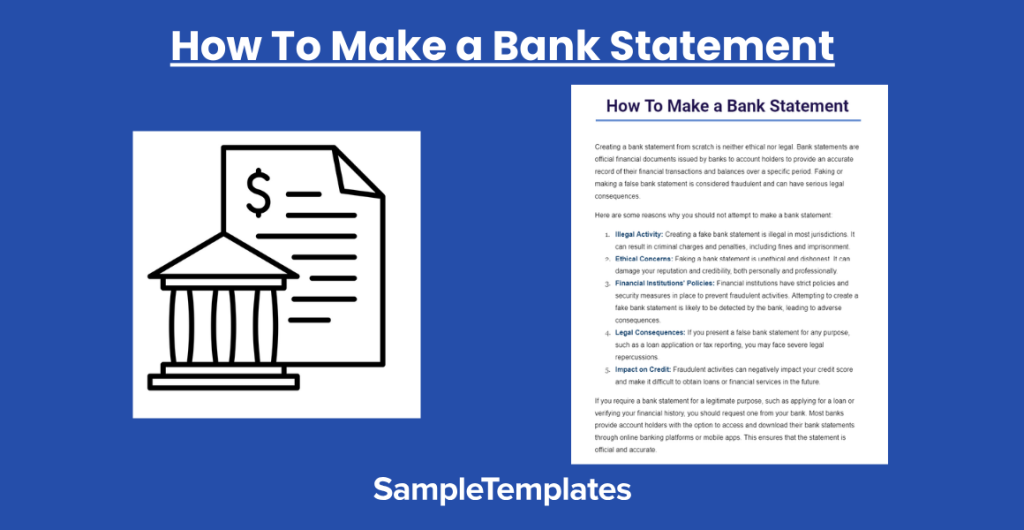
Creating a bank statement from scratch is neither ethical nor legal. Bank statements are official financial documents issued by banks to account holders to provide an accurate record of their financial transactions and balances over a specific period. Faking or making a false bank statement is considered fraudulent and can have serious legal consequences.
Here are some reasons why you should not attempt to make a bank statement:
- Illegal Activity: Creating a fake bank statement is illegal in most jurisdictions. It can result in criminal charges and penalties, including fines and imprisonment.
- Ethical Concerns: Faking a bank statement is unethical and dishonest. It can damage your reputation and credibility, both personally and professionally.
- Financial Institutions’ Policies: Financial institutions have strict policies and security measures in place to prevent fraudulent activities. Attempting to create a fake bank statement is likely to be detected by the bank, leading to adverse consequences.
- Legal Consequences: If you present a false bank statement for any purpose, such as a loan application or tax reporting, you may face severe legal repercussions.
- Impact on Credit: Fraudulent activities can negatively impact your credit score and make it difficult to obtain loans or financial services in the future.
If you require a bank statement for a legitimate purpose, such as applying for a loan or verifying your financial history, you should request one from your bank. Most banks provide account holders with the option to access and download their bank statements through online banking platforms or mobile apps. This ensures that the statement is official and accurate.
If you have concerns or specific needs regarding your bank statement, it is essential to discuss them with your bank or a financial advisor. They can guide you on the proper procedures and legal methods to obtain the documentation you require.
In summary, creating a fake bank statement is illegal, unethical, and can have severe consequences. If you need an official bank statement, it is best to obtain one through the legitimate channels provided by your bank. Always conduct your financial activities with honesty and integrity to maintain a strong financial reputation and stay within the boundaries of the law.
Uses and purpose of Sample Bank Statement
- It provides all the essential bank transactions details.
- It will be helpful in keeping the proper record of the bank transactions and all the incomes records.
- The bank statement conveys all the relevant information of all the queries and differences in the bank’s balances.
- The bank reconciliation statement contains the reasons for all the difference in the bank statement and bank ledgers of the business unit.
- It can be used for future references and audit purposes.
- The bank statement helps to list out all the information on fund transfers.
Need of the Sample Bank Statement
The bank statement is essential for getting all the details and information on the banking transactions for a specific time period. The bank statement records all the transactions done through cash or credits transfers. The bank statement can be helpful in conveying the relevant information to the legal team for audit purpose. The bank reconciliation statement is needed to communicate the reasons and information about the difference in the balances in the banks and ledger or passbooks kept by the business persons or individuals.
Benefits of a Bank Statement

Bank statements are essential financial documents that provide a detailed record of an account’s activity over a specific period, typically monthly. The benefits of regularly reviewing and utilizing bank statements include.
- Tracking Spending: Bank statements allow individuals and businesses to see exactly where their money is going. This visibility is crucial for managing budgets effectively and making informed financial decisions.
- Detecting Fraud: By reviewing your bank statement, you can quickly identify any unauthorized transactions. Early detection of fraudulent activity can help prevent further loss and facilitate the resolution process with your bank.
- Reconciling Accounts: Bank statements are used to reconcile the account balance in your records with the balance reported by the bank. This process ensures that your financial records are accurate and up to date.
- Monitoring for Errors: Bank statements can also reveal errors or discrepancies, such as double charges or incorrect transactions, that can then be rectified with the bank.
- Understanding Fees: They provide an itemized list of any fees charged by the bank, such as monthly maintenance fees, ATM fees, or overdraft charges. Understanding these fees can help you take steps to avoid them in the future.
- Financial Planning: Analyzing your bank statements can help you identify spending patterns and areas where you can save money. This insight is valuable for setting financial goals and planning for the future.
- Credit Applications: When applying for a loan or mortgage, bank statements are often required as part of the application process. They serve as proof of income and financial stability.
- Tax Preparation: Bank statements can assist in tax preparation by providing a record of deductible expenses and income received. They can also serve as documentation in case of an audit by tax authorities.
- Record Keeping: Keeping bank statements is a good practice for maintaining a personal or business financial archive. This documentation can be vital for legal purposes, contract disputes, or future financial analysis.
In essence, bank statements are a valuable tool for financial management, offering transparency, security, and the foundation for sound financial health and planning.
The main benefits of the sample bank statements are to keep proper records and journal of the bank related transactions. The bank statements convey any differences in any transactions and its records. Some transaction may be cleared, or cheques may be returned or canceled. It also mentions the reasons for any cheque return. The bank statements can be used to refer all the details of the bank related transactions and can be utilized in income tax for filing the returns. The bank statement can be employed for future references and for record keeping of the business activity report through the bank.
All the templates for an Income Statement or sample bank statement are available in both format documents and pdf. All the documents are compatible with all the versions, and as we are customer oriented, your satisfaction is our priority. So feel free to give any suggestion or requirement for any improvement as we are always there for our clients.
In conclusion, a bank statement is a vital financial document that provides a summary of a person’s or a business’s financial transactions. It serves as a valuable tool for financial management and record-keeping.
What is bank statement proof?
Bank statement proof refers to using an official bank statement as evidence to support financial claims, transactions, or applications, demonstrating the accuracy of one’s financial history.
Is bank statement proof of name?
A bank statement can provide proof of one’s name indirectly by displaying the account holder’s name, which is typically the same as the legal name of the account holder.
Is bank statement valid?
Yes, a bank statement is valid and serves as an official document provided by a financial institution to account holders, offering an accurate record of financial transactions and balances.
How to check your bank statement
To check your bank statement, log in to your online banking account, navigate to the statement section, and select the relevant period. Alternatively, visit an ATM or contact your bank.
How can I see bank statements?
Access your bank statements online by logging into your bank’s website or app. Navigate to the statements or account history section to view and download your transaction details.
How do I get my 6 month bank statement?
Contact your bank either through their online platform, customer service, or visit a branch. Request a 6-month bank statement, specifying the period needed. They can provide it digitally or on paper.
In conclusion, this bank statement provides a detailed record of financial transactions during the specified period. It is a crucial tool for financial management, offering transparency and accountability. Regularly reviewing this statement ensures accuracy, facilitates budgeting, and supports informed decision-making. We appreciate your diligence in monitoring and maintaining your financial records.
If you have any DMCA issues on this post, please contact us!
Related Posts
FREE 10+ Engineering Problem Statement Samples [ Software, Mechanical, Civil ]
FREE 30+ Information Statement Samples in PDF | MS Word
FREE 50+ Policy Statement Samples in MS Word | Google Docs | PDF
FREE 50+ Summary Statement Samples in PDF | MS Word
FREE 10+ Nursing School Personal Statement in PDF
FREE 9+ Mortgage Statement Samples and Templates in PDF
FREE 10+ Independent Subcontractor Statement Samples in MS Word | Google Docs | Apple Pages | PDF
FREE 10+ Trust Distribution Statement Samples in PDF
FREE 14+ Compliance Statement Samples & Templates in PDF | MS Word
FREE 10+ Extension Impact Statement Samples in PDF | DOC
FREE 10+ Bank Reconciliation Statement Samples and Templates in PDF | MS Word
FREE 10+ Diversity Mission Statement Samples in MS Word | PDF
FREE 10+ Architecture Statement of Purpose Samples [ Sustainable, Graduate, Master ]
FREE 13+ Project Scope Statement Samples in PDF | MS Word
FREE 11+ Internship Statement of Purpose Samples in PDF | DOC
